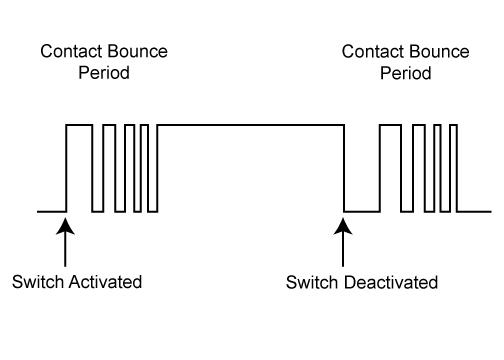Custom low-profile keypad assemblies used in OEM applications incorporate snap-acting dome switches. Dome switches are a type of keypad assembly switch intended for very long cycle life and years of trouble-free use but are intended for logic-level switching, not power switching.
Types of Keypad Assembly Switches
All electro-mechanical switches including dome switches, discrete push button switches, and toggle switches have some degree of contact bounce as the contacts close and open to control electrical current. As the switch contacts stick to each other, their momentum and elasticity act together to cause the switch contacts to bounce apart one or more times before making steady contact. The result is rapidly pulsed electric current instead of a clean transition from zero to full current. This effect is usually unimportant in power circuits but causes problems in logic circuits that respond fast enough to misinterpret the on-off pulses as a data stream.
In user interface assemblies, switches with snap-action generally have lower contact bounce than linear-action switches such as simple push button switches or rotary switches. However, there will always be some degree of switch bounce. In power circuits, designers may use a capacitor connected across the switch to minimize contact bounce but capacitor can degrade the switch contact points. Using a capacitor across the switch contacts will beat the switch bounce down but will definitely kill long-term switch performance. Inexpensive, non-snap switches typically have a very short life and killing the switch a little earlier may not be a problem for disposable or low-use applications. However, high reliability applications with our dome switches can last several million operating cycles depending on the specific dome switch used.

Switch Bounce Diagram in a Keypad Assembly
Dome Switches
Our dome switches feature very low closing and opening switch bounce - less than 2 ms, and typically well less than 1 ms. Using either a software debounce scheme or a Schmitt trigger such as 74HC14 to buffer the switch for simple circuits is recommended. Software debounce is performed with a micro-controller. When the microprocessor senses a switch-state change (high to low or low to high), a delay loop is initiated for a short time, approximately 3 ms and the switch state is checked again. The delay loop and repetitive state sensing occurs for 5 to 10 cycles. When the sampled switch state remains the same for 4 or 5 delay cycles in a row, the switch state is steady and can be used to trigger an action that is associated with the switch.
The software debounce is easy to accomplish as long as there is a microprocessor in the application and the switch sense delay cycles does not introduce enough delay that is noticeable to the user. Without a microprocessor in the application, use a Schmitt trigger to accomplish the switch debounce.
Switch Settling Time & Debounce Methods
The bounce time for keypad switches depends on the switch closure event itself and can vary for different switch types. This largely depends on the operation of the key itself. Settling time is generally less than 100ms, with most being much less. To eliminate bouncing, there are hardware or software options. Hardware will change the BOM cost, and the improvements are not always perfect. For software, when detecting the change of the key switch event, you can try a delay of about 10ms and then test the key situation again. This should help you achieve a stable response.
Summary
If you are developing a custom keypad user interface for your application, always consider which type of switch is the best option for you. Here at Epec, we tailor our keypad and assembly design technologies to support the best design and construction for the intended application. Each core technology has features and advantages that we compare in order to aid in the best choice for your application.
Key Takeaways
- Switch Bounce is Inevitable but Manageable: All mechanical switches, including dome switches, experience some level of contact bounce, which can cause unintended signals in logic circuits. Understanding how bounce occurs is critical for designing reliable keypads.
- Dome Switches Offer Minimal Bounce: Compared to other switch types, dome switches have exceptionally low bounce times, often less than 2ms. This makes them ideal for high-reliability applications that require long cycle life and precise signal processing.
- Debounce Methods: Hardware vs. Software: Debouncing can be handled using hardware components like Schmitt triggers, which physically filter out unwanted noise, or through software algorithms, which introduce a short delay (~10ms) before registering a keypress to ensure signal stability.
- Switch Settling Time Varies by Design: The time required for a switch to fully settle can differ based on the switch mechanism. While most settle in under 100ms, careful design considerations can further minimize unwanted bouncing and improve system responsiveness.
- Optimizing Keypad Performance: Choosing the right debounce strategy, switch type, and circuit design helps ensure keypad assemblies function efficiently without introducing lag or reliability issues. Proper testing and design refinements can prevent costly failures in real-world applications.















